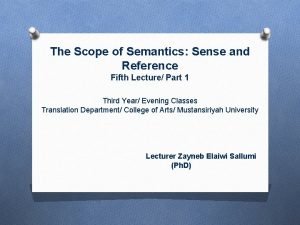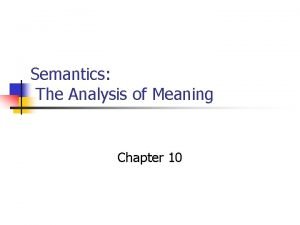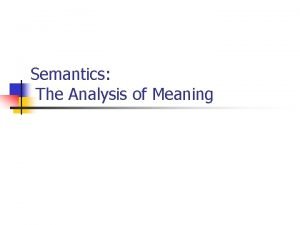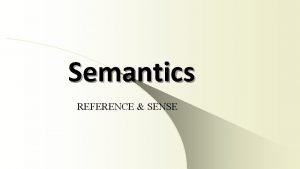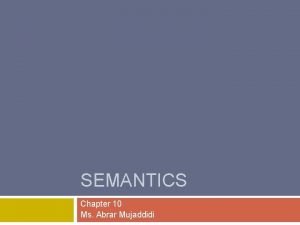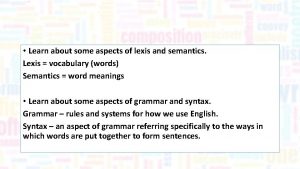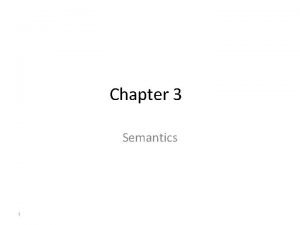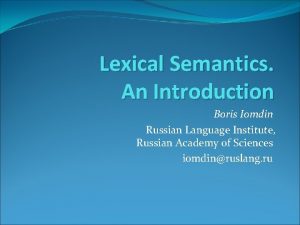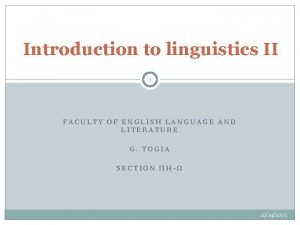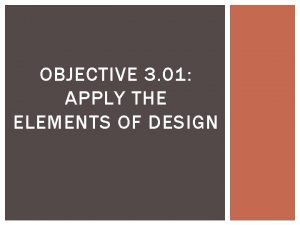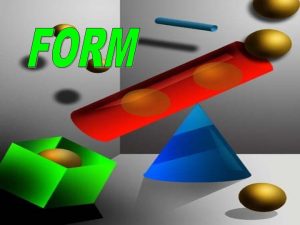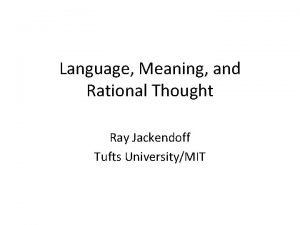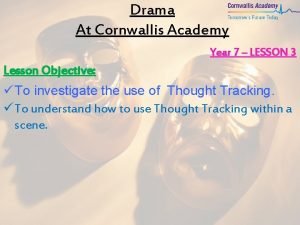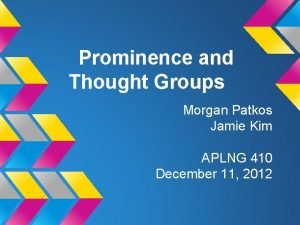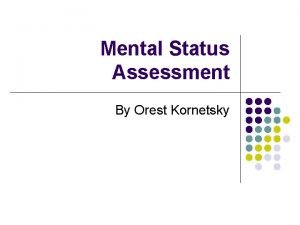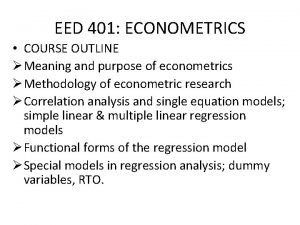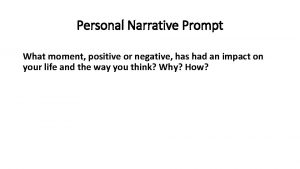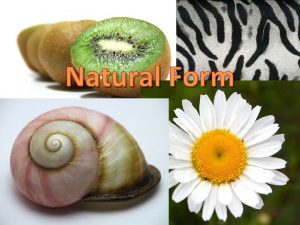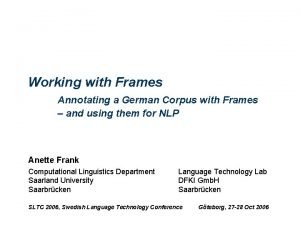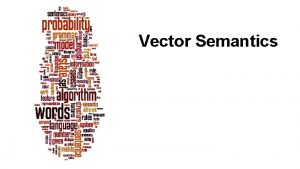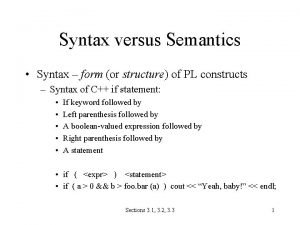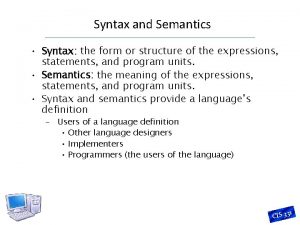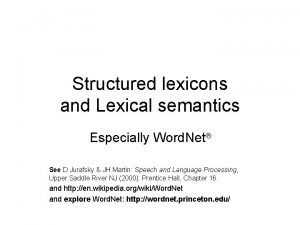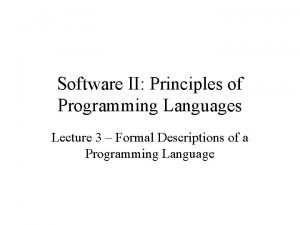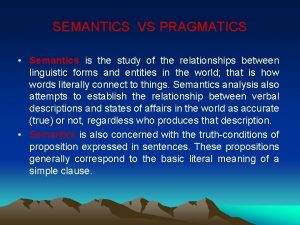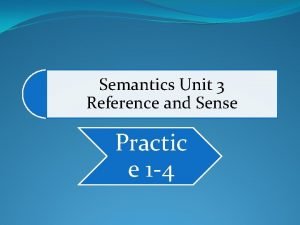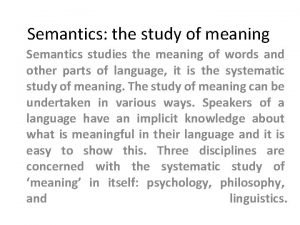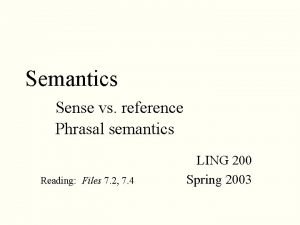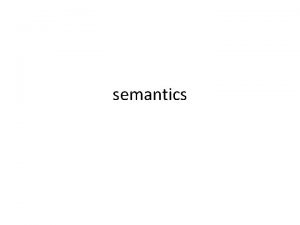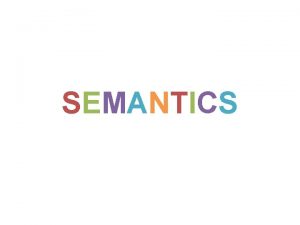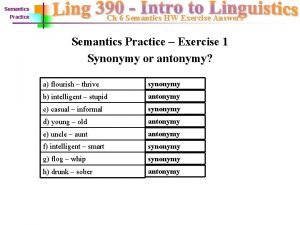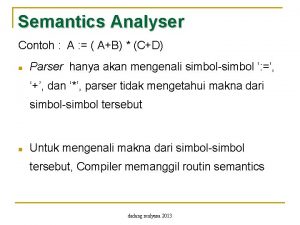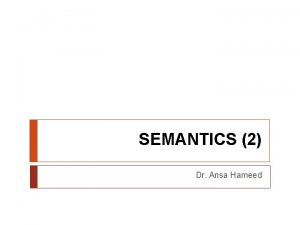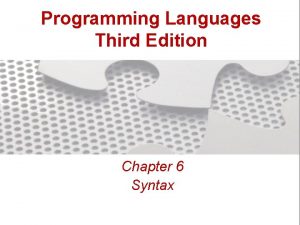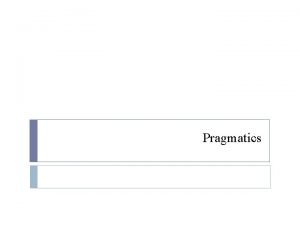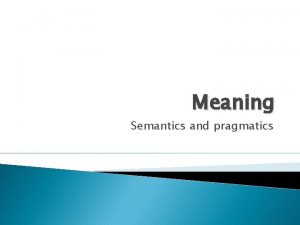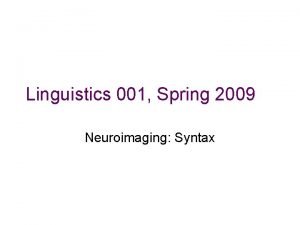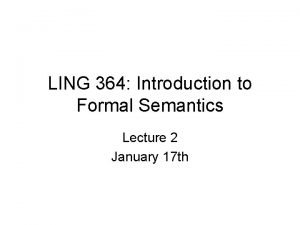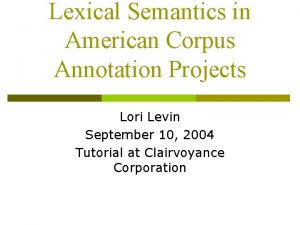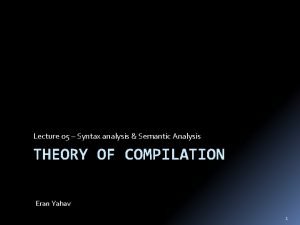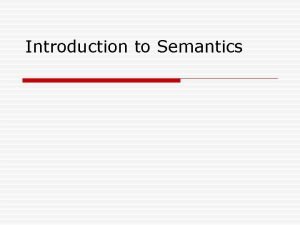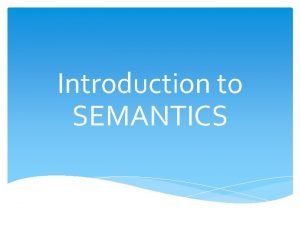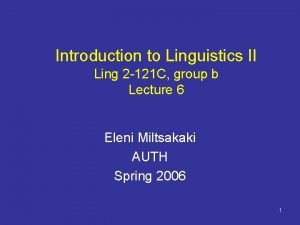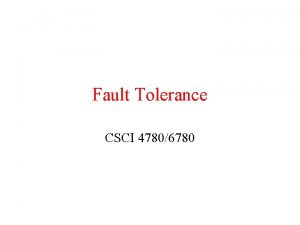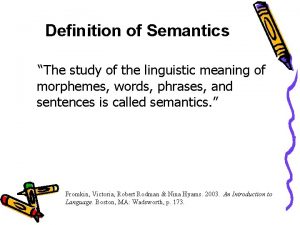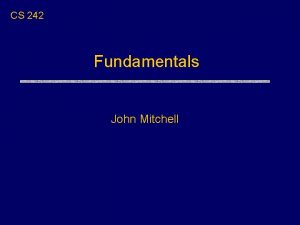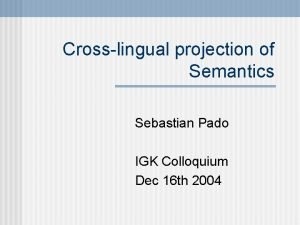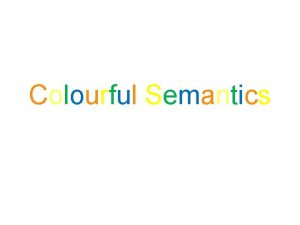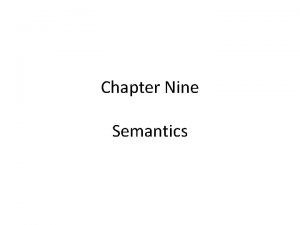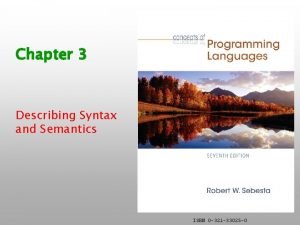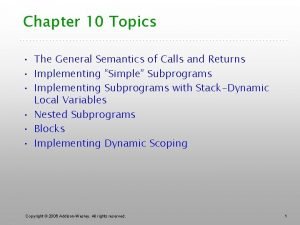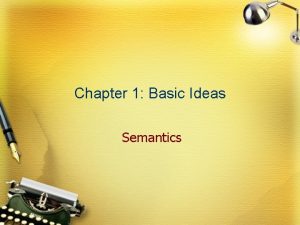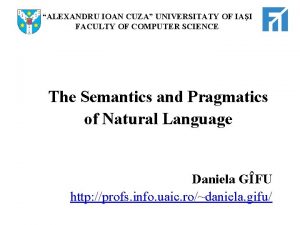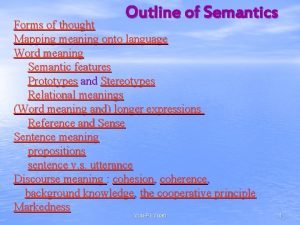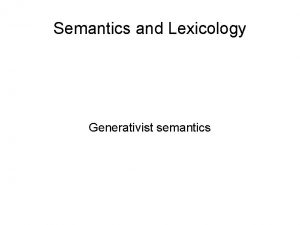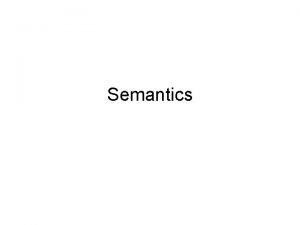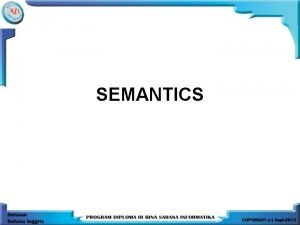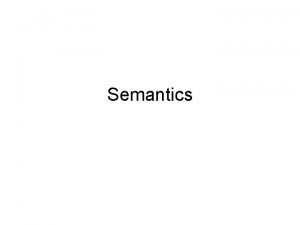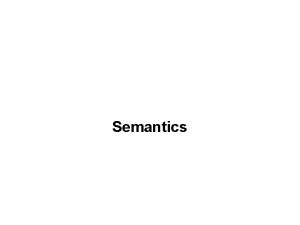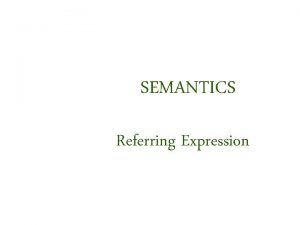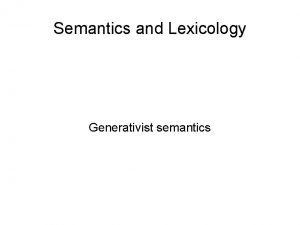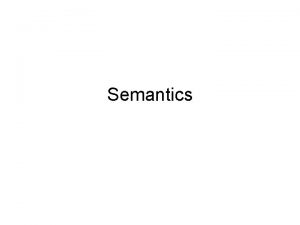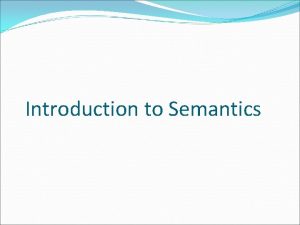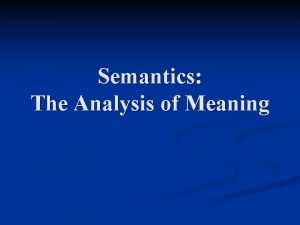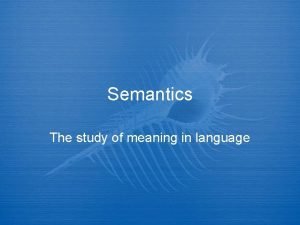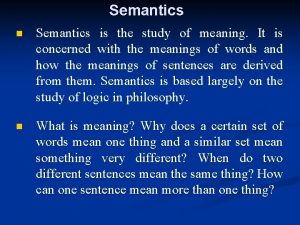Outline of Semantics Forms of thought Mapping meaning















































![Proposition, Sentence, & Utterance (3) physical actions [gestures] mental processes [thoughts] abstract semantic entities Proposition, Sentence, & Utterance (3) physical actions [gestures] mental processes [thoughts] abstract semantic entities](https://slidetodoc.com/presentation_image/1463f9d8e67e47e7ace72a6ed1b27e8d/image-48.jpg)


























- Slides: 74

Outline of Semantics Forms of thought Mapping meaning onto language Word meaning Semantic features Prototypes and Stereotypes Relational meanings (Word meaning and) longer expressions Reference and Sense Sentence meaning propositions sentence v. s. utterance Discourse meaning: cohesion, coherence, background knowledge, the cooperative principle Markedness Yun-Pi Yuan 1

Forms of thought • A thought may be compared to a cloud shedding a shower of words. • Mental representation: Have you ever had the experience of wanting to express a thought, but you couldn't find the words for it? • Language is NOT the basic form of thought. (Then, what is? ) Yun-Pi Yuan 2

Mental Representation • Mental imageries: A. sound images B. visual images C. math D. movement—action patterns Yun-Pi Yuan 3

Sound Images • You can “play” music in your head, no? • Reading music Yun-Pi Yuan 4

Visual Images • “Pictures in your mind” • How do you find your way home? – “see” the whole bus/car route home to school • Remembering scenery: the apt. I stayed in NYC, in Hsintien, and the one I stay now. • Recognizing people: matching pictures already in memory with what you see now. • Painters: Michelangelo • Matching colors; dressing. Yun-Pi Yuan 5

Math • Doing math problems in your head. (“Hsin Swan” 心算) Yun-Pi Yuan 6

Movement (Action Patterns) • How to tie knots, use tools, dance, write Chinese calligraphy, tie your shoes, braid hair, use chopsticks, etc. • Books explained with pictures and words: often easier just to follow pictures – E. g. , origami Yun-Pi Yuan 7

Transfer among Different Forms of Thought • Yes, we do it all the time: e. g. We describe pictures in mind in words; form pictures from words heard; put some sort of process into math—then explain in words; for dance draw pictures of steps, etc. • Therefore, language is not the basic form of thought. (And we don’t really know what it; maybe these forms are all basic, & we have some sort of code that allows us to convert one to another). Yun-Pi Yuan 8

Semantics • However, we’re interested here in semantics, the study of meaning in language, so basically we’re most concerned with how meaning is represented in language, but since we can convert one form of mental representation to another, semantics is related to all forms. • Importance of meaning: the basic function of language is communication • Difficulty to define “semantics” completely Yun-Pi Yuan 9

Mapping Meaning onto language (1) • Examples English, Chinese, & Spanish: He gave me a pen. Turkish: Babam bana topu verdi. (father to-me ball gave) (Nash 92) actor recipient object action (possessed by speaker) (definite) (past, 3 rd person, singular) (witnessed by speaker) Hebrew: Aba natan li (daddy gave me et ha kadur. the ball) actor action recipient object definite object particle (past, 3 rd person, singular, masculine) Yun-Pi Yuan 10

Mapping Meaning onto Language (2) • None of these languages marks all the possible elements of meaning or everything we know (e. g. , sex of the receiver, how recently when the event occurred, how the giving was done). • All these could be marked in language and each language chooses different aspects to mark. • So, semantic elements are lang. specific. Yun-Pi Yuan 11

Mapping Meaning onto Language (3) • Examples of “possession”: A. my shoes • can be thrown away when worn out, but other people not likely to wear them B. my chair • but other people can sit in it C. my nose • has nothing to do with others, nor will I “throw it away” Yun-Pi Yuan 12

Mapping Meaning onto Language (4) • Note the differences: A. He has a big nose. (“Have”: I “possess” something; more general than “own”) B. *He owns a big nose. (You cannot own parts of your body; only materials or object which you can give away or buy/sell it, can be owned. ) C. He is the possessor of his big nose. (“Possess”—closer to “own” than to “have”) Yun-Pi Yuan 13

Mapping Meaning onto Language (5) • How does a child learn semantics? • Slobin Model (Nash 91) KNOWLEDGE of the world Parts of KNOWLEDGE marked in HUMAN LANGUAGE Parts of KNOWLEDGE marked in language X (language the child is learning) Yun-Pi Yuan 14

Mapping Meaning onto Language (6) • Semantics is concerned with the bottom two parts of the diagram: universal semantics (2 nd part) part and the semantics of particular languages (3 rd part • The child first learns about the world, then aspects that have to be marked in language in general, and aspects that have to be marked in specific language. • The child has to learn which aspects of situations the grammar requires us to mark: – Time, physical characteristics of objects, psychological, physical, & social aspects of the people involved & many other things. . Yun-Pi Yuan 15

Mapping Meaning onto Language (7) • The child’s problems of mapping meaning onto language: A. Which aspects of knowledge of world would likely to be marked? B. Which aspects must be marked in a particular language? C. How are they marked? (words; word order, affixes, function words, …) • So, we’ll look at various attempts to explain how some aspects of our knowledge of meaning are expressed in language. Yun-Pi Yuan 16

Word Meaning • Word meaning including: A. features B. prototypes C. stereotypes D. relational meanings (degree, direction) E. reference and sense (take us into semantics of longer expressions) Yun-Pi Yuan 17

Features • Definition: more basic concepts/ideas that cannot be “defined” any further; primitive semantic elements. • Combinations of features: [+ -] (e. g. , see Nash 94 -95) A. Advantages 1. a universal element found in all langs. (Nash 95) 2. similar to phonological features B. Disadvantage: very limited application Yun-Pi Yuan 18

Advantage 1: Universal • While we may speak different languages, we’re all humans with the same human brain, & perceive the world with the same human senses. e. g. [+HUMAN], [+ANIMATE], [+ROUND], [+MALE], [+FEMALE], [+LIQUID], [- MOVEABLE], etc. Yun-Pi Yuan 19

Advantage 2: Similar to Phonological Features • Psychologically similar to phonological features • Same kind of mental operation; from phonology semantics, the use of [+ -] • Phonemes: defined by its features e. g. /p/=+consonantal, -voiced, +stop, +bilabial Yun-Pi Yuan 20

Disadvantage • Very limited application—do not work for many words e. g. A. chair/stool/bench/bean bag B. ugly/beautiful C. red/green D. table/desk E. book/pamphlet • Lead to idea of prototypes • [activity: have some students draw a “tree”] Yun-Pi Yuan 21

Prototype (1) • Definition: a typical/ideal example (serving to represent the whole class); an examplar • Concept of prototype: helps to explain meaning of certain words in terms of resemblance to the clearest examplar. • Eleanor Rosch’s experiments: – A psychologist at the Univ. of California at Berkeley – Carried out experiments in order to test the idea that people regarded some types of birds as “birdier” than other birds, or some vegetables more vege-like, or some tools more tooly – Questionnaires passed to more than 200 psychology students Yun-Pi Yuan 22

Prototype (2) • • • A category name (e. g. , fruit, vegetable, bird, clothing, etc. ) About 50 examples for each category Rate how good an example of the category is, on a 7 -point scale • Results: surprisingly consistent A. bird: – Robin, sparrow, canary, dove, lark, parrot, owl, . . . peacock, duck, . . . penguin, ostrich, . . . bat B. clothing: – shirts, dresses, skirts, pajamas, bathing suit, shoes, stockings, tie, hat, gloves C. vegetable: – pea, carrot, cauliflower, . . . onion, potato, mushroom Yun-Pi Yuan 23

Prototype (3) • Judgment not based on frequency of usage of the word (though likely to have some effect) nor on the basis of appearance or use • People seem to have some idea of the characteristics of an ideal examplar (in Rosch’s words, a “prototype”). Then they match other terms against the features of the prototype to determine if it’s a member of the same category (i. e. , sufficiently similar to the prototype, but not have to share all its characteristics). Yun-Pi Yuan 24

Stereotype • Definition: • a list of typical characteristics which describes the prototype • more abstract representation of possible qualities • e. g. bird • feathers, wings, beak, fly, lay eggs. . • e. g. , elephant • gray, very thick-skinned, hairless, with a trunk and two tusks, heavy (adult: weighing several tons) Yun-Pi Yuan 25

Relational Meanings • Words may differ +- a feature (e. g. , man/boy, • • • man/woman). But, many sets of words differ, or may be grouped, in other ways, including “degree” and “direction. ” Degree: amount—contrast to +- of features e. g. , hot/cold, long/short, tall/short, hard/soft, good/bad, wet/dry, beautiful/ugly Direction: buy/sell, come/go, give/receive, borrow/lend, read/write. Note: A. “father”—also relational (in a different way) B. “kill” and “hurt”—cause and effect relations (Nash 95, 96) Yun-Pi Yuan 26

Longer Expressions • Our examples of features for words like “father, ” “kill, ” “hurt, ” etc. seem to remain at the word level. word meanings interact with syntax • However, we have to use phrases and even clauses (e. g. , “x causes y pain”) to get at word meaning. • So, word semantics cannot be separated from the semantics of longer units of language, to which we now move reference & sense. Yun-Pi Yuan 27

Reference & Sense (1) • Reference and sense: applying to semantics of both • words and longer expressions Reference: dealing with the relationships between language and the world (Nash 98); part of language that refers to WHAT/Sth. (a real thing or person) in the world. e. g. “My son is in the beech tree. ” (identify person) (identify thing) the largest city in Taiwan the students in the linguistics class my husband, dragon, ghost, all your children will be handsome Yun-Pi Yuan 28

Reference and Sense (2) Sense: dealing with relationships inside the language. Something in the head; “extra meaning” or an abstract idea—concerned with relations within language itself; relations with other words. e. g. The moon was bright last night. (reference, refers to a certain object) My love is like the moon. (sense, something more is involved in the phrase “the moon” than just the object) Yun-Pi Yuan 29

Reference and Sense (3) • Sense but not reference: function words, such as • • and, or, never, perhaps, otherwise, but. These make connections between meanings of different units of language. Every expression that has meaning has sense, but not every expression has reference. Same reference but different sense: e. g. The evening star west. (sunset) The morning star Venus east. (sunrise) Same object (same reference) but different sense (different aspect); different ways of referring to the same thing (i. e. , the planet you see at different time) Yun-Pi Yuan 30

Reference and Sense (4) • The same word can have more than one sense (i. e. , meaning). For example, “bank” a. I have an account at the Bank of Scotland. b. We steered the raft to the other bank of the river. c. The DC-10 banked sharply to avoid a crash. d. The banks of dark cloud promised rain. e. Who do you bank with? f. Hospital blood banks have saved many lives. Yun-Pi Yuan 31

Reference and Sense (5) • Other examples: my father/ the man who married my mother (same reference? Could be different? Different senses/meaning? ) • Could have different reference e. g. stepfather or illegitimate child 我先生/孩子的爸 different senses, although refer to the same person (=same reference) Yun-Pi Yuan 32

Reference and Sense (6) • Examples of reference/sense (Nash 99 -100) • When I said “Turn in your homework, ” I meant the homework due today. • When my niece said in Taiwanese that she wanted a cup of “te”, she meant drinking water, not tea. • “That’s the man!” “Which man do you mean? There are several men there. ” • What does semantics mean? • It’s hard to say exactly what love means. • Partial means “not complete. ” Yun-Pi Yuan 33

Reference and Sense (7) • In the above examples the first three reference (use “refer to”); the 2 nd three examples sense (cannot use “refer to”) • In every day conversation, the words “meaning, ” “mean, ” etc. are used to indicate “reference” sometimes, and “sense” other times. Yun-Pi Yuan 34

Sentence Meaning (1) • Proposition= the basic idea/thought of the sentence; • events or states; say something about events/states. Proposition: predicate +argument(s) (Nash 19 -20. 84+) Aspect of entity, quality, state, activity, relation with other entity/ things. entity (some sort of thing) • A sentence can have more than one propositions. • Proposition: – only linguistic element, without interpersonal meaning – corresponds roughly to a complete independent thought Yun-Pi Yuan 35

Sentence Meaning (2) • sentence: – sentence or propositional meaning only • utterance: – what speakers say or write; you can give the time, date, place of an utterance – includes: intonation, stress, patterns, gestures – has propositional and contextual (or interpersonal) meaning Yun-Pi Yuan 36

Sentence • Definition: a unit of language (an abstract thing, a part of language itself); a string of words put together by the grammatical rules of a language. • Meanings of a sentence come from only within the language, independent of context. Yun-Pi Yuan 37

Utterance • What speakers say or write: you can give the time, date, • • • place of an utterance (including intonation, stress, patterns and gestures) An event in the world which can be thought as an example of a sentence, or of part of a sentence (e. g. , a phrase or a word) Definition: the meaning of an utterance comes from both the language & the context & from features of language (e. g. intonation, stress, gestures) Different functions in context: statement of fact explanation suggestion denial thanks apology tease promise insult request, compliment e. g. Mr. Nash likes tea. (Nash 20) argument predicate (shows relationship) Yun-Pi Yuan 38

Sentence Meaning (3) • Propositional meaning (sentence) vs. interpersonal meaning (utterance) • Proposition (Nash 84 -85) vs. utterance (Nash 100 -101) analysis: • e. g. “The book is open. ”—accusation “Tom opened the book”— defense against accusation; put blame on someone else Yun-Pi Yuan 39

Sentence Meaning (4) • Examples of utterance: “Can you open the window? ”—mother to child (order) “Is your homework ready? ” –student (=can I copy it? ) –teacher students (=now, turn it in) • Meaning of utterances based on the context (depending on the interactions of the speakers and their relationship). Yun-Pi Yuan 40

Sentence Meaning (5) • Sentence vs. utterance e. g. He loves her. —sentence “He loves her. ”—utterance (in a movie/novel; with context) (understand, but who are they? ) (with knowledge of reference of pronouns) • Expressions without propositional meaning, only interpersonal meaning: e. g. Hello, Goodbye, pardon, Hey, Hooray ( something like verbal gestures); (Nash 101) Yun-Pi Yuan 41

Sentence Meaning (6) • Utterance meaning has to be determined from the context (intentions of speaker/hearer, their relationship; the time, place, roles) • Sentence meaning (propositions) is independent of context. Yun-Pi Yuan 42

Sentence Meaning (7) • Practice: Utterances Sentences Propositions Can be loud or quiet Can be grammatical or not Can be true or false In a particular regional accent In a particular language Yun-Pi Yuan 43

Sentence Meaning (8) • Practice: Utterances Sentences propositions Can be loud or quiet + - - Can be grammatical or not Can be true or false + + - + + + In a particular regional accent In a particular language + - - + + - Yun-Pi Yuan 44

Sentence Meaning (9) • Utterance – A concrete thing; an event – Can be spoken or written, context involved • Sentence – An abstract linguistic unit or structural form – An abstract unit (including linguistic content) – Flesh + frame • Proposition – Ideas, concepts; very loosely structured thinking – Flesh only Yun-Pi Yuan 45

Proposition, Sentence, & Utterance (1) • Family tree relationship: proposition sentence utterance utterance Yun-Pi Yuan 46

Proposition, Sentence, & Utterance (2) • A single proposition could be expressed by using several different sentences (e. g. , “He killed Jane, ” or “Jane was killed by him”) and each of these sentences could be uttered an infinite number of times. • “I do. ” = a sentence, but can be uttered several times different utterances – Elizabeth Tayor married several times. Every time when she said, “I do. ” a different utterance. Yun-Pi Yuan 47
![Proposition Sentence Utterance 3 physical actions gestures mental processes thoughts abstract semantic entities Proposition, Sentence, & Utterance (3) physical actions [gestures] mental processes [thoughts] abstract semantic entities](https://slidetodoc.com/presentation_image/1463f9d8e67e47e7ace72a6ed1b27e8d/image-48.jpg)
Proposition, Sentence, & Utterance (3) physical actions [gestures] mental processes [thoughts] abstract semantic entities [propositions] linguistic entities [e. g. sentences] actions [e. g. utterances] Yun-Pi Yuan 48

Discourse (1) • Language longer than a sentence; naturally spoken or written language in context – Paragraphs, conversations, interviews, etc. • Important at many levels: syntax + morphology; meaning; discourse structures— the structures of units longer than a sentence. • Textbook e. g. : (Nash 101) The monster danced with Yang Li-Hua. He enjoyed it. She didn’t. – It shows meaning & syntax have to be analyzed in units longer than a sentence. Yun-Pi Yuan 49

Discourse (2) • Examples of different discourse structures A. writing a. paragraph b. composition (longer organization) c. book (chapter…) d. story—typical structure: chronological order e. sonnet, 五言絕句,七言律詩 B. apartment descriptions: American vs. Chinese Yun-Pi Yuan 50

Discourse (3) • In conversation, discourse grows between speakers—many “discourse pairs” – Greeting/greeting; Q/A; compliment/reply (accept or reject); complaint/apology, etc. (interpersonal meaning obviously involved here) • Conversation: casual/classroom/ ordered discussion/debate/interview/ritual (e. g. church ritual, graduation, wedding ritual, classroom ritual—起立. 敬禮. 坐下. 報告) Yun-Pi Yuan 51

Discourse (4) • Some important elements in discourse: cohesion, coherence, background knowledge, the co-operative principle • Cohesion: – “the ties and connections which exist within texts. ” – Something which exists in the language – Two kinds of links: • Grammatical Text: a piece of spoken • Lexical or written language. Yun-Pi Yuan 52

Cohesion (1) • Examples of cohesion: (Yule 140) pronouns, (e. g. he, my, I , it); lexical connections (e. g. Lincoln convertible—the car —the convertible); general connections with shared meaning elements (e. g. “money”— bought—saving—penny—worth a fortune— sold—pay); relationship marker (e. g. “however”); tense—first 4 sentences: past tense, last one: present—a different time. Yun-Pi Yuan 53

Cohesion (2) • Cohesion: the grammatical and/or lexical relationships between the different elements of a text. This may be the relationship between different sentences or between different parts of a sentence. Example: A: Is Jane coming to the party? B. Yes, she is. There is a link between Jane and she, also between is… coming and is. Yun-Pi Yuan 54

Coherence (1) • The relationships which link the meanings of • utterances in a discourse or of the sentences in a text. These links may be based on the speakers’ shared knowledge (background knowledge) e. g. A: Could you give me a ride home? B: Sorry, I’m visiting my sister. There’s no grammatical or lexical link between A’s Q and B’s reply, but the exchange has coherence, because both A and B know that B’s sister lives in the opposite direction to A’s home. Yun-Pi Yuan 55

Coherence (2) • Coherence: that the text makes sense— coherence achieved more by people than by texts (than by language itself)—we expect coherence—we “try to arrive at an interpretation which is in line with [our] experience of the way the world is” (Yule 141). • Generally, a paragraph has coherence if it’s a series of sentence that develop a main idea (i. e. , with a topic sentence and supporting sentences which relate to it). • An example of coherence without cohesion (Yule 142) Yun-Pi Yuan 56

Coherence (3) • A cohesive text, without coherence (Yule 141) • Coherence: sth. Which exists in people (experience of the world); beyond linguistic knowledge (i. e. , beyond knowledge of the world, of how conversational interaction works) • Obviously, there’s something else involved [what is it? ] in the interpretation of a conversation, except the information expressed in the sentences. Yun-Pi Yuan 57

Coherence (4) • It is clear that language users must have a lot of knowledge of how conversational interaction works which is not simply “linguistic knowledge. ” • This leads us to Conversational Interaction (e. g. , turn-taking, pauses, see Yule 143144 read on your own) and Background Knowledge and Co-operative Principle. Yun-Pi Yuan 58

Background Knowledge • Examples (Yule 146 -47)—inference, build-up, changing inference first two sentences: Who is John? How’s he traveling? (plane? boat? ) 3 rd sentence : Who’s John? (How traveling? ) 4 th sentence: Who’s John? 5 th sentence: surprise • We create what the text is about (not just the text does this), based on expectations of what normally happens (=background knowledge). Yun-Pi Yuan 59

The Cooperative Principle (1) • In conversation participants are assumed (by others) to be cooperating. (Yule 145 -146) • Four Maxims: set out by Grice (1975) Quantity: as informative as is required; no more, no less. Quality: Don’t say something you believe to be false or something you don’t know. Relation: Be relevant. Manner: Be clear, brief, and orderly Yun-Pi Yuan 60

The Cooperative Principle (2) • These are the normal expectations: • e. g. , expectations about Quantity: “To make a long story short, ” “I won’t bore you with all the details. ” • Quality: “As far as I know”; “Correct me if I am wrong”; “I think”; “I feel”; “It’s possible that…” (“maybe”) Yun-Pi Yuan 61

The Cooperative Principle (3) • The 4 maxims and the whole principle allow interpretations (see Yule 145 bottom) Carol: Are you coming to the party tonight? Lara: I’ve got an exam tomorrow. – Lara assumed to be relevant + informative (quantity): exam tomorrow study tonight no party tonight (relying on background knowledge) – Imagine: she replies: “Linguistics is interesting. ” • Just a brief introduction to Discourse—many more elements involved, very complex. Yun-Pi Yuan 62

Lexicon (1) • Lexicon: – the set of all the words & idioms of any language – a mental system which contains all the information a person knows about words • Q: Do the lexical items (words) of a language have • • some sort of overall structure/organization like phonology, morphology, and syntax have? No; not reducible to rules—instead a listing of meanings—different from other aspects of language; not predictable from overall rules. What’s the exact nature of a unit for definition? That is, what is a lexical unit (a word)? Yun-Pi Yuan 63

Lexicon (2) • Dictionary entry is not exactly what we think of as a word. It’s really a paradigm: an example of all the forms of a word, used to represent the whole set. • Examples: child (the word listed; “head word”)— represents child, child’s, children’s take—take, takes, taking, took, taken. • Some sets include only one member: how, yet, often Yun-Pi Yuan 64

Lexicon (3) • How is the paradigmatic form chosen? • e. g. find a new word in the dictionary: • ritualistic look up what? – ritual • larger look up? – large Yun-Pi Yuan 65

Unmarked • The paradigmatic form is the unmarked form: the form which does not seem “special” in any way; the form that seems most “basic”, that has nothing added (phonemes, sounds, morphemes). e. g. child: child’s, children large: larger car: cars ritual: ritualistic strangle: strangulation old/young: “How old is she? ” the normal Q (Which is acquired first? ) Yun-Pi Yuan 66

Markedness (1) • Markedness: theory that in the languages of the • world certain linguistics elements are more BASIC, NATURAL, and FREQUENT (these elements are unmarked; less basic, natural, frequent elements are marked) Examples: A. Singular/plural nouns: car—cars (plural derived from singular in English, so singular=unmarked; plural = marked) B. S-V-O sentence: I dislike such people. O-S-V sentence: Such people I dislike. Which is marked and which is unmarked? Yun-Pi Yuan 67

Markedness (2) • Marking may be a basic principle for assigning universal (and possibly innate) values to certain kinds of features Slobin Model (Nash 91) Yun-Pi Yuan 68

Markedness (3) C. Frequency: more frequent = ? e. g. falling intonation vs. rising intonation D. Common: more common = ? (more specific = marked) e. g. dog vs. bitch E. Distribution: unrestricted (or less restricted in degree) = unmarked e. g. How tall is John? vs. How short is John? (also, which is more natural? ) Yun-Pi Yuan 69

Markedness (4) • Markedness theory applies at all levels: A. phonology: e. g. /p, t, k, s, n/ unmarked consonants /v, z, Q, ð/ more marked (less common) falling intonation=unmarked rising intonation=marked B. lexicon: e. g. dog vs. bitch (marked) C. morphology: e. g. car vs. cars (marked) D. syntax: e. g. active vs. passive (marked) Yun-Pi Yuan 70

Markedness (5) • Discourse: e. g. politeness too polite (marked) Would you be so kind just let me borrow your pencil for a minute? unmarked Could you lend me a pencil? Yun-Pi Yuan too informal (marked) Without saying anything, just grasp the pencil. 71

Markedness (6) • Unmarked elements: easier to acquire • Marked elements: more difficult to acquire • Some experimental evidence shows that teaching marked forms can lead to faster acquisition of both marked and unmarked forms, but teaching only unmarked forms won’t help students learn marked forms. Yun-Pi Yuan 72

Markedness (7) • Problem: • Judging markedness still mostly by intuition (but, can we trust that? ) • Which is marked? – his/her – easy/difficult – early/late – dangerous/safe Yun-Pi Yuan 73

Homework • On markedness: Yule 125 D (i) • small/big, short/long, wild/tame, cheap/expensive, near/far, many/few, early/late, dangerous/safe, good/bad, fresh/stale, easy/difficult, strong/weak, thick/thin, wide/narrow, full/empty Yun-Pi Yuan 74
 Compare procedural semantics and declarative semantics.
Compare procedural semantics and declarative semantics. Complete incomplete thought
Complete incomplete thought The associative mapping is costlier than direct mapping.
The associative mapping is costlier than direct mapping. Forward mapping vs backward mapping
Forward mapping vs backward mapping Transform mapping dan transaction mapping
Transform mapping dan transaction mapping What is a quote sandwich examples
What is a quote sandwich examples Reference and sense in semantics
Reference and sense in semantics Hyponyms examples for grade 3
Hyponyms examples for grade 3 Semantics means
Semantics means Site:slidetodoc.com
Site:slidetodoc.com Reflective meaning in semantics
Reflective meaning in semantics Lexical and grammatical meaning
Lexical and grammatical meaning Meaning of semantics
Meaning of semantics Communicative translation definition
Communicative translation definition Polysymy
Polysymy Lexis and semantics meaning
Lexis and semantics meaning Descriptive meaning in semantics
Descriptive meaning in semantics What is the language in
What is the language in Associative meaning in semantics
Associative meaning in semantics Why are related forms more agreeable than unrelated forms?
Why are related forms more agreeable than unrelated forms? Short form i am not
Short form i am not Why are related forms more agreeable than unrelated forms
Why are related forms more agreeable than unrelated forms Why are related forms more agreeable than unrelated forms?
Why are related forms more agreeable than unrelated forms? Weak and strong forms
Weak and strong forms Mary o neill
Mary o neill Thought meaning
Thought meaning Definition of thought tracking
Definition of thought tracking English group
English group Loose associations
Loose associations Recall mapping marketing
Recall mapping marketing L process
L process What is fieldwork in geography
What is fieldwork in geography Course outline meaning
Course outline meaning Topic outline example
Topic outline example Lecture outline meaning
Lecture outline meaning A form that is natural
A form that is natural Market forms of meat does undergo chilling
Market forms of meat does undergo chilling 6 main forms of energy
6 main forms of energy Karusmäki
Karusmäki Vector semantics
Vector semantics Semantics vs syntax
Semantics vs syntax Syntax vs semantics
Syntax vs semantics Lexical semantics
Lexical semantics Grammar vs syntax vs semantics
Grammar vs syntax vs semantics Semantics is the study of
Semantics is the study of Different expressions have the same referent
Different expressions have the same referent Study of meaning of words
Study of meaning of words Sense vs reference
Sense vs reference Semantics is the study of
Semantics is the study of Presupposition examples
Presupposition examples Polysemy synonymy, hyponymy and antonymy
Polysemy synonymy, hyponymy and antonymy Hw
Hw Contoha
Contoha Example of semantics
Example of semantics Syntax programming
Syntax programming Difference between semantics and pragmatics
Difference between semantics and pragmatics Semantics summary
Semantics summary Example of semantics in linguistics
Example of semantics in linguistics Formal semantics
Formal semantics Lexical semantics
Lexical semantics Syntax vs semantics
Syntax vs semantics Introduction to semantics
Introduction to semantics Contradiction in semantics
Contradiction in semantics Sentential semantics
Sentential semantics Rpc semantics in the presence of failures
Rpc semantics in the presence of failures Sentential semantics
Sentential semantics Syntax vs semantics
Syntax vs semantics Frame semantics
Frame semantics Colourful semantics describe
Colourful semantics describe Definition of semantics with examples
Definition of semantics with examples Syntax vs semantics
Syntax vs semantics Semantics of call and return in ppl
Semantics of call and return in ppl Basic ideas in semantics شرح
Basic ideas in semantics شرح Examples of pragmatics
Examples of pragmatics Sentential semantics
Sentential semantics






